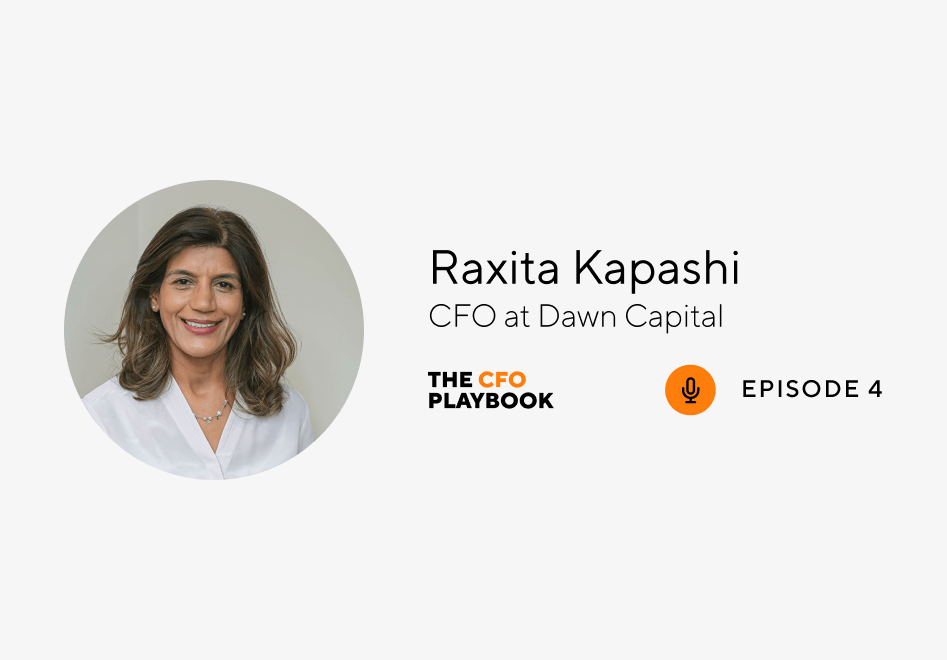A lot of a CFO’s time is spent managing their team, and with good reason. Team dynamics often directly impact the efficiency and competency of a department and the company itself.
Raxita Kapashi is the CFO at Dawn Capital, and one of the things that drew her to the venture capital firm in 2019 was its inclusive and diverse workplace.
A healthy workplace environment is carefully cultivated by its leaders, Raxita says, and if you can build a strong team, you will have a strong company.
We recently had Raxita on The CFO Playbook where she talked about who she hires into her team, how she trains employees, and what kind of mindset she has instilled in the finance department at Dawn Capital.
Here are her thoughts on how you can build a strong team culture in the workplace.
1. Hire the right people
A good team begins with good employees – but how do you know you’ve found the right person for the job?
Raxita has found, through trial and error, that hiring the right person requires more than just an interview and looking through a candidate’s CV. This is what she does instead: before she interviews each candidate, Raxita gives them a test she devises herself to make sure they have the right skills for the job.
But there’s more – she also avoids overselling the position she is hiring for, and is very honest with each candidate about what their position will entail, which helps keep their expectations in check.
If you can get the right team members, you’ll have a strong starting point for a cohesive workplace environment.
2. Train your employees well
Training is vital to producing confident and competent employees. The more they understand about their role and how the company works, the quicker they can produce quality work.
Though it requires more time upfront, Raxita likes to give a step-by-step demonstration for her new employees:
‘I’ll often go through a piece of work and explain to them how I would approach it. That gives them comfort that they’ve got the tools to do the piece of work.’
But the training doesn’t stop there. Raxita checks in regularly with her employees, gives them feedback on projects, and tries to foster an environment of continual learning. Everyone benefits from this. So, it’s as simple as: if you invest in your employees’ training, your department will benefit in the long run.
3. Communicate clear expectations
Clear communication will help your team function at its best.
To communicate with her department and help everyone stay on task, Raxita uses a project management tool – Asana – that allows her to keep track of work. She assigns tasks and receives email alerts when someone has completed a task – and can follow up if a task hasn’t been completed.
Though the pandemic has made communication more difficult, Raxita has regular meetings with her team members and tries to maintain an open-door policy. This gives her the chance to stay in the loop and check in with them, and they feel supported as employees.
As the saying goes, communication is a two-way street. Be clear about your expectations for your employees, but also make an effort to be available to answer questions and offer support.
4. Instill a learning mindset
Giving your employees opportunities to learn helps them to grow in their abilities, and their increased skills also benefit your company.
For Raxita’s team, training never really ends. She encourages her employees to be in a continual state of learning, whether that means obtaining new certifications or attending a training course.
Dawn Capital also hosts a ‘lunch and learn’ session once a month, where the whole firm gets together during their lunch hour and a speaker gives a talk on a particular topic pertinent to the company.
Model a mindset of continual learning for your employees. When you set high standards, your employees will rise to the occasion.
5. Make sure your team members feel valued
When employees feel valued, they contribute to a positive team culture. Their happiness becomes contagious.
Raxita loves the culture at her company:
‘At Dawn, we embrace integrity, and integrity fosters a good company culture. It’s important for all team members to have a voice and to know that they are listened to.’
As a leader, you play a big role in building your workplace culture. It’s in your best interest to show your employees how much you value them – and the best way to do this is to listen to what they have to say.
You are responsible for you team’s success
A good CFO knows that they are ultimately liable for their team’s triumph or failure – what you choose to do has a direct impact on your work environment.
What kind of team culture are you trying to foster? How do you want your employees to feel about where they work? How can you manage your team better? And how can you help them be better?
When your employees feel that they are part of a team, they will want to contribute to that team and achieve more, together. Build up your company’s team mindset, and your employees will give you their best.
Listen to the full conversation
Hear the full interview with Raxita Kapashi, and catch up on the latest episodes at CFOPlaybook.fm










